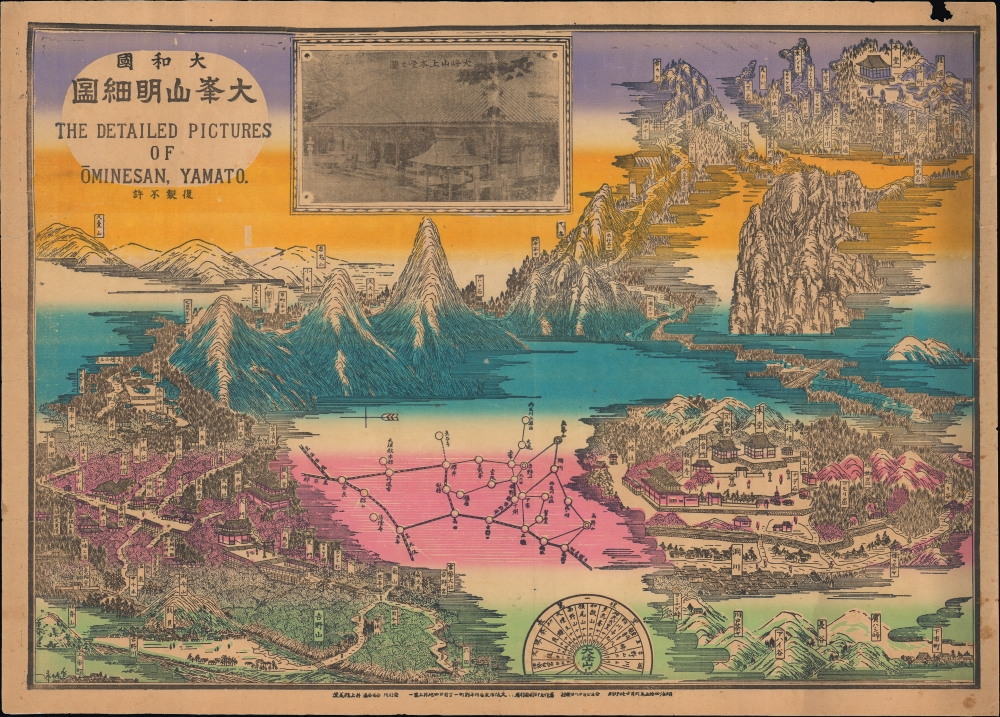This item has been sold, but you can get on the Waitlist to be notified if another example becomes available, or purchase a digital scan.
1912 Inoue View of Mt. Omine and Environs, Nara, Japan
Ominesan-inoue-1912$175.00

Title
大和國大峯山明細圖 / The Detailed Pictures of Ōminesan , Yamato.
1912 (dated) 14.5 x 20.5 in (36.83 x 52.07 cm)
1912 (dated) 14.5 x 20.5 in (36.83 x 52.07 cm)
Description
This is a 1912 view of Ōminesan or Mt. Ōmine (大峰山) and surroundings near Nara, Japan, prepared by Inoue Seibidō. This area contains multiple shrines and temples, particularly for the Shugendō (修験道) tradition, which had been strongly suppressed by the government in the preceding years.
There are two main paths to reach the Ōminesan-ji, one from Mt. Yoshino, at left here, passing through Kinpusen-ji, and another from Dorogawa (洞川), at right, each taking about three to four hours to reach the temple. Given the distances involved, over the centuries, various wells (井) were dug, while teahouses (茶ヤ) and other services catering to travelers arose. Given the area's spiritual significance, many additional temples, gates, halls, tombstones, and other structures were constructed over time, while surrounding hot springs, forests, and mountains were designated as sacred.
A Closer Look
The view is oriented towards the southeast, effectively looking at the mountains from Nara. The titular mountain and its important temple, Ōminesan-ji (marked as 本堂 here), appear at the top-right, with nearby locations on paths to the mountain labeled. On Mt. Yoshino (吉野山, referring to a series of peaks rather than a single mountain as its name implies) at the bottom-left is the complex of the Kinpusen-ji (金峯山寺), with its prominent Main Hall (蔵王堂, the second largest wooden structure in Japan today). To the right of the title at the top is an inset view (from a photograph) of Ōminesan-ji. Towards the bottom is an inset railway map, oriented towards the east, displaying connections to nearby towns and cities, including Nara (奈良). At the bottom is an intriguing table of distances shaped in a semicircle, with Ōminesan at the center and various locations (including cities, mountains, temples, and shrines) on the spokes or rays around the semicircle, with their distances noted.Ōminesan-ji (大峯山寺) and Kinpusen-ji (金峯山寺)
The main attractions for visitors to this region are two ancient mountaintop temples, the Ōminesan-ji and Kinpusen-ji, set amidst beautiful surroundings. The temples are the two most important to the Shugendō tradition, a proto-religion based on asceticism and mountain worship that developed in the Heian Period (794 - 1185 CE) and later merged with Shinto and Buddhism. The temples claim origins as far back as the late 7th century, but the present Ōminesan-ji structure was built in 1691 and expanded in 1706, while the Main Hall of Kinpusen-ji was built in 1590. Historically, the two temples were considered part of a whole despite being separated by more than 20 kilometers, and both were said to have their origins with the semi-mythical ascetic En no Gyōja (役 小角, c. 634 - 707), the founder of Shugendō. Significantly, following the Meiji Restoration (1868), popular religious practices, including Shugendō, were suppressed, and the government moved to separate Buddhism from Shintoism, which had largely amalgamated at the popular level. Initially, the two temples were assigned to the newly formalized and centralized State Shinto hierarchy, but in 1886 they were declared Buddhist and separated from each other.There are two main paths to reach the Ōminesan-ji, one from Mt. Yoshino, at left here, passing through Kinpusen-ji, and another from Dorogawa (洞川), at right, each taking about three to four hours to reach the temple. Given the distances involved, over the centuries, various wells (井) were dug, while teahouses (茶ヤ) and other services catering to travelers arose. Given the area's spiritual significance, many additional temples, gates, halls, tombstones, and other structures were constructed over time, while surrounding hot springs, forests, and mountains were designated as sacred.
Publication History and Census
This view was prepared by Inoue Seibidō (井上精美堂), a local publisher, in 1912 (Meiji 45). Only a small number of works were published by Inoue Seibidō, and all relate to this region and its temples; some catalog listings credit their works to one Inoue Kenichi (井上貫一), surely the owner and founder of the publisher. The appearance of an English title here is curious, even perplexing; perhaps some foreign tourists had ventured to the region, but it may just have been an attempt by the publisher to appear fashionable and modern. The employment of a bright, multicolored ink palette, either imported European inks or a domestic product heavily influenced by them, was likewise common at the time. In any event, the present work is seemingly very rare; it does not appear in any institutional catalogs in Japan or abroad.Condition
Fair. Closed edge tears professionally repaired on verso. Closed tear extending 2.5 inches into printed area from left margin professionally repaired on verso. Closed tear extending 2.5 inches into printed area from right margin professionally repaired on verso. Slight loss to margin in upper right corner not affecting printed image.

